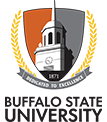General Education: Mission, Role, and Process
Guided by Buffalo State's Principles of Student Learning Outcomes Assessment, the Office for Institutional Effectiveness and Planning (IEP) works with the Senate Intellectual Foundations Oversight Committee (SIFOC) to assess the efficacy of the general education curriculum and outcomes. The Mission of the Intellectual Foundations General Education is:
“To promote an understanding of the continuity of human history, the depth of inherited knowledge, the validity of diverse modes of inquiry, the value of artistic expression and the richness of our collective experience. The purpose of the Intellectual Foundations program is to develop the skills and habits of the mind required for a life of intellectual curiosity and civic engagement.”
SIFOC deploys Oversight and Assessment Committees (OAC) that are composed of approximately 4-6 faculty/professional staff and faculty librarians, who serve as liaisons with faculty teaching in the general education. The SIFOC OACs, with the guidance of the Associate Vice President for Institutional Effectiveness and Planning are charged to design, refine, and execute Buffalo State's Assessment Plan for general education on an annual and ongoing basis.
The results of Buffalo State's general education program assessment are available on the Reports page.
The General Education Assessment Process
Phase 1: Preparation
1. In the preceding semester: The Associate Provost announces the committee memberships for the Oversight and Assessment Committees (OAC). Each OAC is assigned to one area of the General Education curriculum. Each OAC has an Administrative Liaison (usually an Associate Dean), a SIFOC Liaison, and three to four other members of the faculty who serve as liaisons.
2. In the preceding semester: The Office of Institutional Effectiveness and Planning (IEP) works with Deans Offices to notify faculty members of the upcoming assessment process. IEP offers orientation sessions to help faculty understand the process and to connect each faculty member with an OAC Liaison.
Phase 2: Data Gathering
3. Week 3: For all courses being assessed, IEP distributes a student survey in week 3 of the semester to measure their perceived level of familiarity with the material specified in each Student Learning Outcome (SLO).
4. Week 13: For all courses being assessed, IEP distributes a student survey in week 13 of the semester to measure their perceptions of having developed confidence in the material specified in the SLO.
5. End of the Semester: For all courses being assessed, IEP distributes a faculty survey at the end of the semester to 1) gather reflections on what went well, what might be changed, etc. and 2) to collect samples of student work that represent that which:
Did not meet the standard
Approached the standard
Met the standard
Exceeded the standard
As they are most familiar with the course, the assignments, and the scholarly material, "the standard" is determined by the faculty member teaching the course.
Phase 3: Analysis and Reporting
6. IEP assists the OAC with data analysis. The OAC completes its report and submits it to IEP.
7. The report is shared with SIFOC for recommendations which are added to the report by IEP.
8. IEP shares the report with the campus.
Phase 4: Actions
9. The following semester: Deans Offices follow-up with departments to discuss the findings and SIFOC recommendations. Possible topics of conversation might include: What changes are planned to improve student learning? Are courses organized in ways that recognize and incorporate the SLOs? Should courses remain in the general education program or be removed? Should new courses be added to the general education program?
10. Deans Offices report their actions and follow-up to the IEP. These actions are added to the report, which is shared with Deans Office and department chairs.
Assessment Roles & Responsibilities
The purpose of IEP is to coordinate the overall process by preparing the faculty, implementing the data collection, facilitating data analysis, and communicating results.
The assessment process is very faculty-driven. All courses included in the general education program will be included in the assessment. Participation is expected. Instructors are responsible for understanding the SLOs and incorporating them into their courses. Additionally, instructors are responsible for assessing and reporting student learning for each SLO.
Each OAC is charged with assisting participating course instructors with any help they may need or request. Additionally, OACs are charged with completion of a report that summarizes the collected data. Accordingly, the memberships of the Oversight and Assessment Committee (OAC) change to allow for appropriate representation among members of the faculty. Additionally, the OAC includes a small number of SIFOC members who act as liaisons between the two committees. When two areas of General Education are being assessed, two OACs will be formed. If three areas are assessed, three OACs are formed.
Upon receiving the final report from the OAC, SIFOC is expected to reflect on the report and make recommendations for actions and follow-up. These recommendations are communicated to IEP and added to the report before it is shared with the Deans Offices.
Deans Offices play an important role at both the beginning and end of the assessment process. Typically, Associate Deans fill the role of Administrative Liaisons on the OACs. Early in the process, Associate Deans communicate with the faculty to boost participation. Data suggest that active involvement by the Deans Offices significantly increases faculty participation. Later in the process, Deans Offices work with departments to reflect on the findings, plan any actions that will be taken in light of the findings, and report those actions to IEP. In this way, Buffalo State is able to complete the assessment process and "close the loop" with a model that fosters continuous improvement.

